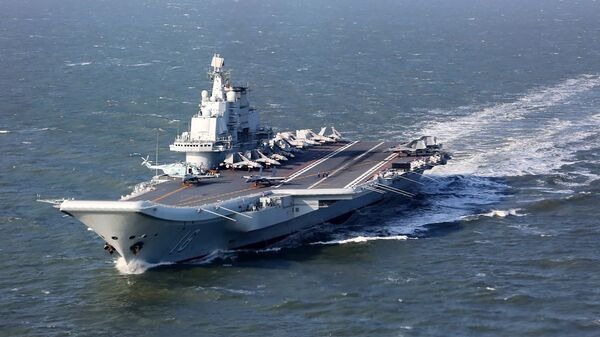In recent years, China's navy has transformed from a small fleet into a formidable force aimed at gaining dominance in the Pacific. In the 1990s, Beijing launched several projects to design and construct advanced submarines, destroyers, frigates and corvettes.
In 2012, China’s first aircraft carrier, the Liaoning, was commissioned. The ship was originally laid down as a Soviet multirole aircraft carrier under the name Riga and then Varyag. China bought it from Ukraine for $25 million and at the time it was already 60 percent completed.
Currently, Beijing is developing its own aircraft carrier program. By 2020, the Chinese naval forces are expected to receive several domestically-built aircraft carriers.
While completing the Liaoning, Chinese companies developed radio-radar equipment for the ship as well as certain types of weapons and special equipment for planes. As for the 001A, the Chinese defense industry completed a full development and production cycle, including building the aircraft carrier’s hull and the power plant.
As a newer vessel, the 001A will carry more advanced radio-electronic systems than the Liaoning. Moreover, a lot of minor fixes were added to its design, based on the Chinese experience maintaining the Liaoning.
Kashin also suggested that more rational space planning will allow for increasing the size of the ship’s wing.
“The idea that the Liaoning will be a training ship while the 001A will be the first combat ship is mistaken. It is also incorrect to say that both ships are not very useful in combat because they lag behind the US aircraft carriers. But they will expand the capabilities of China’s navy in the event of a conflict, especially in the South China Sea,” Kashin told Sputnik China.
Kashin said that the two ships will probably complete tasks near the islands China claims in the South China Sea, including missile defense, reconnaissance and target indication tasks. Both aircraft carriers will also coordinate with other Chinese naval ships involved in anti-access and area denial (A2/AD) missions.
“Their presence in the area will create problems for any potential enemy’s anti-submarine aviation and communications. Their deployment will also create conditions for using H-6K missile carrying bombers in the area. The air defense situation will also improve for China’s navy. Finally, the ships can be used to protect the combat alert areas of Chinese submarines in the South China Sea,” Kashin said.
He underscored that these Chinese aircraft carriers are not designed for the global projection of power, which makes them cheaper and more reliable.




